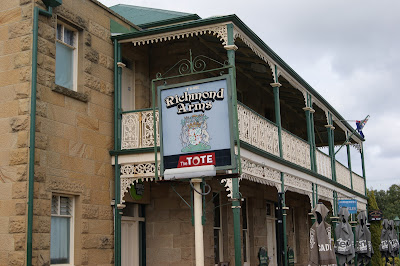Richmond is a picture-perfect town that tells the story of an early Australian colonial village - hand-made brick and mellow stone on the banks of the Coal River.
Towards the end of 1803, a party from Lieutenant Bowen's settlement at Risdon Cove explored eastwards, hunting kangaroo and emu; they discovered coal and named the Coal River. Land grants to settlers encouraged settlement in the area. In 1823, the erection of the Richmond Bridge facilitated travel to the east coast, and the Tasman Peninsula, as settlers pushed further in search of land.
Richmond was proclaimed a town by Lieutenant Governor Sorell in 1824. It played an important role as a convict station and military outpost in the early days of the colony. For much of its history it was the main gateway to the east coast and the Tasman Peninsula. In 1824, the township of Richmond was named, following a complex land deal in which the protagonist was David Lord. Ninety acres of his Richmond Park estate were exchanged for 1400 acres adjacent to his property.
In the 1820s, Richmond became one of Lieutenant-Governor Arthur's police districts; the gaol, the court house, the barracks and a watch house were erected. Richmond continued to grow, largely because of its importance as a convict station and a military post.

In the 1830s, Richmond's position on the route to the East Coast and the Tasman Peninsula made it a natural overnight stopping place. By the 1830s, several roads led into and out of the town. Inns increased in number. Businesses were established. There were eventually blacksmiths, wheelwrights, saddlers, stockyards, tanneries, a market place, a pound, brick and lime kilns, as well as general stores and other services.

In the 1850s, two coaches each day linked Richmond with the Restdown ferry at Risdon or Kangaroo Point at Bellerive. For most of the nineteenth century, the Coal River was accessible through Pitt Water, and there was considerable trade with Hobart. In 1872, the opening of the Sorell causeway (which caused the river to silt) and the extension of the Hobart-Launceston railway line through Campania had a dramatic effect on Richmond's growth. For the next one hundred years, Richmond was a stable, quiet rural community.
In the 1970s, awareness of the significance of Richmond's heritage began to develop. At the same time, Richmond grew as an arts and crafts centre, with a number of galleries opening. Richmond became recognised as an important Tasmanian tourist destination. More recently, the Coal River Valley has seen a diversification of agriculture, which has included the establishment of a number of successful vineyards.
This information © Dr Dianne Snowden
Richmond is a live, vibrant community that in its architecture and structures has remained true to its past. You'll find Australia's oldest Catholic church and bridge in Richmond, a well-preserved convict jail, colonial cottages and quite stately manors, all reminiscent of a time one mostly reads about in historical archives. Richmond Bridge was built by convict labor between 1823 and 1825 and the nearby Catholic church, St John's, was built in 1836. Walk on the bridge and wander in the church's cemetery for glimpses of a past long gone. Richmond Gaol, built in 1825, was used to house convicts, as well as bushrangers and Aborigines imprisoned there
Richmond Bridge (1823). Originally named Bigge's Bridge, Richmond Bridge is Australia's oldest bridge still in use. It was built by convicts from sandstone quarried at Butchers Hill and hauled by hand carts to the bridge site. The cutwaters were added in 1884. The bridge is said to be haunted by several ghosts, including Grover, a cruel flagellator.
St John's Catholic Church (1837) and burial ground. This is the oldest Catholic Church still in use in Australia. The church has had three spires. The present one was raised in 1972.
Richmond Gaol was built in 1825 as part of Governor Arthur's system of police districts. The building was added to in the 1830s and was last used as a gaol in 1928. One of its infamous inmates was convict Ikey Solomon, said to be the model for Dicken's Fagin.
St Luke's Anglican Church (1834). The foundation stone was laid in 1834 by Governor Arthur. Designed by John Lee Archer and built by convict labour, the church was completed in 1835. James Thompson, the convict who was responsible for the original timber work inside the building, was granted his freedom as a reward for his work.
Richmond Court House. The Court House was built in 1825. In the early days, it was also used for church services. It was used as Council Chambers from 1861, when the Richmond Municipality was established, until 1993, when Richmond Council amalgamated with Clarence City Council.
Congregational Church (1873). The first Congregational Church was built in 1844 in Torrens Street and was demolished in 1876 after it was damaged in a storm. The church in Bridge Street was built in 1873.
Olde Hobart Town Miniature Village. For a view of how Hobart used to be, the Old Hobart Town historical model village provides a Gulliver-like experience among the Lilliputian recreation of the old city.
As Tasmania’s most important historic town, Richmond is one of the state’s most popular destinations, the perfect base for exploring Tasmania’s South East. Historic, romantic, family friendly, a hub for food and wine lovers with its fresh food and fine wines, grown in fertile soils under the world’s cleanest air. Good examples of Tasmania’s stark convict heritage and beautiful historic buildings. The town is as elegant today as it was in the 1820’s, when it was an important military staging post and convict station linking Hobart with Port Arthur. Nestled in the Coal River Valley, this classified historic town is famous for its Georgian architecture. The stone buildings now house galleries, teashops, craft boutiques and museums, offering every convenience and luxury to the modern visitor.
